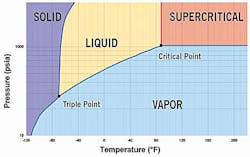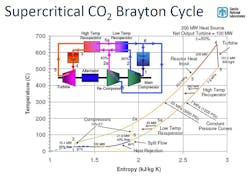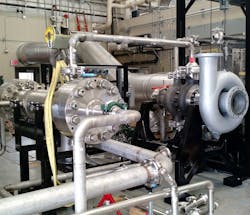Much of the world’s electricity comes from turbines powered by steam created by the heat from nuclear reactors, solar collectors, and burning fossil fuels. Most of those turbines and power plants use the Rankine cycle in which pressurized water is boiled into steam and then expanded through a turbine to turn a generator, a roughly 33% efficient process. That means 67% of the heat created is thrown away as waste and not converted into electricity. (For comparison, Thomas Edison’s first steam-powered generator in 1892 was 1.6% efficient.)
To wring more efficiency from the process, engineers in national labs and private industry are developing turbines based on a recompression closed Brayton cycle (RCBC) and using supercritical carbon dioxide (CO2) as the working fluid. These setups have efficiencies of 50% or more. “They’re basically like jet engines running in a closed loop with CO2 as the working fluid,” says Darryn Fleming, a researcher at Sandia National Lab working on CO2 technology. “And every one percent efficiency increase in a power plant in today’s market translates into millions and millions of dollars, because less fuel is burned to make the same amount of electricity. A one percent improvement in efficiency also reduces greenhouse gases by about 2.9%. Increasing efficiency to 50% will cut emissions by 34%. Plus, consumer costs decline as efficiency improves and fewer natural resources are consumed.”
This phase diagram for CO2 shows at what pressures and temperature the material is solid, gas, and liquid. The transition line indicates where it goes from one phase to another. At 5.2 bar and −56°C, however, CO2 is at its triple point, the temperature and pressure at which it can exist in equilibrium in the liquid, solid, and gaseous states.
Supercritical Benefits
The critical point of a substance is defined by a specific pressure (the critical pressure) and temperature (the critical temperature). When a substance is a vapor and above its critical temperature, no amount of pressure will transform it from a vapor to a liquid until it reaches its critical pressure. But when that substance is a vapor and at its critical temperature, it can be liquified at its critical pressure. And when a substance is above its critical temperature and critical pressure, it becomes supercritical. In the case of CO2, the critical temperature is 87.98°F and its critical pressure is 72.9 atm (1,071 psi). For water, H20, the critical temperature is 705°F and its critical pressure is 218 atm (3,200 psi).
Supercritical substances perform like a liquid/gas hybrid with characteristics halfway between both states. For example, supercritical fluids have liquid-like densities but gas-like viscosities. Like gasses, supercritical fluids also expand to fill the container they are in. They also undergo large changes in density with small changes in pressure or temperature—a major plus for its efficiency in powering turbines. Put simply, using CO2 as the working fluid means it takes less work to convert a given amount of thermal input to electricity, regardless of the source of heat (fossil fuel, nuclear, or solar). The mixture is also non-toxic, non-flammable, inert, available inexpensively in a pure form, and does not damage the environment if there is a leak or spill.
Another benefit of using CO2 to power turbines is that with its liquid-like density, the compressor needs less pumping power and therefore saves energy. At its critical point, CO2 is about half the density of water. With any supercritical fluid, the ease of compressibility goes up with its density. So, CO2 is easier to compresses than steam, and the amount of work done during the compression phase—normally accounting for 25% of the work performed inside the system—is dramatically reduced; the energy saved there greatly contributes to the turbine’s overall efficiency. It also takes less work to cycle it back to the heat source for re-expansion.
With CO2 as the working fluid, the generating plant can function with a smaller, less-expensive compressor and turbine. So, if fuel costs are a significant part of the overall costs (as with coal and natural gas), this means lower fuel costs. And if capital investments are high (as with nuclear and concentrating solar power), the initial investment can be lower since the turbine and equipment can be smaller.
The high fluid density of CO2 lets its use compact and highly efficient turbomachinery. For example, it can use simpler, single-casing body designs while steam turbines require several turbine stages and associated casings, as well as additional inlet and outlet piping.
Supercritical carbon dioxide is optimal for powering turbines because it doesn’t go through a phase change at any point during the cycle. Supercritical carbon dioxide is also very dense; at its critical point, the fluid is about half the density of water. So, in addition to being easier to compress, less work is required to cycle it back to the heat source for re-expansion.
CO2 also brings a bit more green to power plants. When using it in a closed-circuit, sealed Brayton cycle (as Sandia plans), there is no water consumption or contamination, and no hot waste water to get rid of. So, there is no thermal pollution or water pollution. And because the overall process is more efficient, less fossil fuels or nuclear energy are needed and greenhouse gas and/or nuclear waste production go down. The turbines can also use dry cooling, making the powerplants suitable for arid regions where water is scarce.
Further, due to its superior thermal stability and non-flammability, direct heat exchange from high temperature sources to CO2 is possible, permitting higher working fluid temperatures and therefore higher cycle efficiency. And unlike two-phase flow, CO2’s single-phase nature eliminates the necessity of a heat input for phase change that is required for the water to steam conversion, thereby also eliminating associated thermal fatigue and corrosion.
This graphic shows how much smaller a CO2 turbine is than a steam turbine with the same output. The CO2 turbine is being designed and built by Echogen.
Working with CO2
There are several companies and government agencies developing CO2 technology. One of the most prominent is Sandia National Laboratory. It has researchers working on projects with the DoE that will deliver CO2 technologies tested and ready for commercialization. Sandia also plans on maintaining a few CO2 10-MW turbines for testing new equipment to be used for more powerful reactors by 2035.
One of the first steps in this DoE effort is to develop a fully operational 550˚C, 10-MWe R&D Demonstration of an CO2 Brayton Power Conversion System by 2019 that will let other companies, as well as national labs, identify and minimize the technical risks and test components and materials for the commercial application of this technology. Sandia hopes to develop useful technologies and components such as bearing and seals to make the turbine possible. Once it is up and running, Sandia will use it as a testbed, letting partner companies test new approaches and components on it.
For example, to withstand the temperatures, speeds, and loads of the spinning turbine and compressor shaft, Sandia is exploring foil bearings with Xdot, a company that develops and manufactures foil bearings. They are a type of air bearing that can support shafts on a spring-loaded foil journal. Once the shaft is spinning fast enough, air (or CO2) pushes the foil from the shaft, so there is no contact and no wear. They withstand very high and low temperatures.
One company working on foil bearings for the Sandia turbine is Xdot. “Ball bearings don’t work well in the CO2 environment,” says Xdot founder Erik Swanson. “We have a foil bearing that can be directly lubricated by CO2 with better performance at lower cost—a better mousetrap.”
This hardware is part of DoE’s effort to test and demonstrate machinery for getting cost-effective power from solar power stored and concentrated as heat using CO2 thermodynamics. (Photo courtesy of Southwest Research Institute)
Another company tackling the CO2 challenge with Sandia is Flowserve, a company that makes seals. Flowserve’s seals for CO2 power turbines hold tight against CO2 going into the turbine at 1,290°F (700°C) and 4,400 psi. According to Lionel Young, director of advanced technology for Flowserve, his company started from scratch on a seal that could perform in CO2. “Although the high pressure and speeds for this application are not new for us, such a seal hadn’t been designed for these extreme temperatures,” he says. “The critical part has been designing the secondary dynamic gasket. The seal for the most part relies on conventional technology but the dynamic gasket, which must slide and seal, has to work at these extreme pressures and temperatures without leaking.”
Researchers at Sandia will also explore various other uses for CO2 turbines, including supplement existing Rankine cycle plant power generation by capturing waste heat energy without disrupting the original power block. Echogen Power Systems, for example is developing its Thermafficient Heat Engine specifically to harvest waste heat and convert it to power using a CO2-based power cycle. The goal is to use some of the 280,000 MW of waste heat tossed away annually in the U.S. Echogen points out that the waste heat could supply 20% of the U.S. electricity needs while cutting greenhouse gas emissions by 20%, saving consumers $70 to 150 billion per year.




